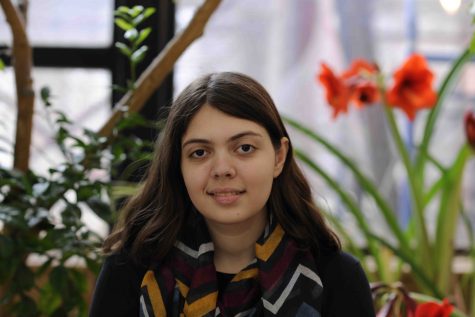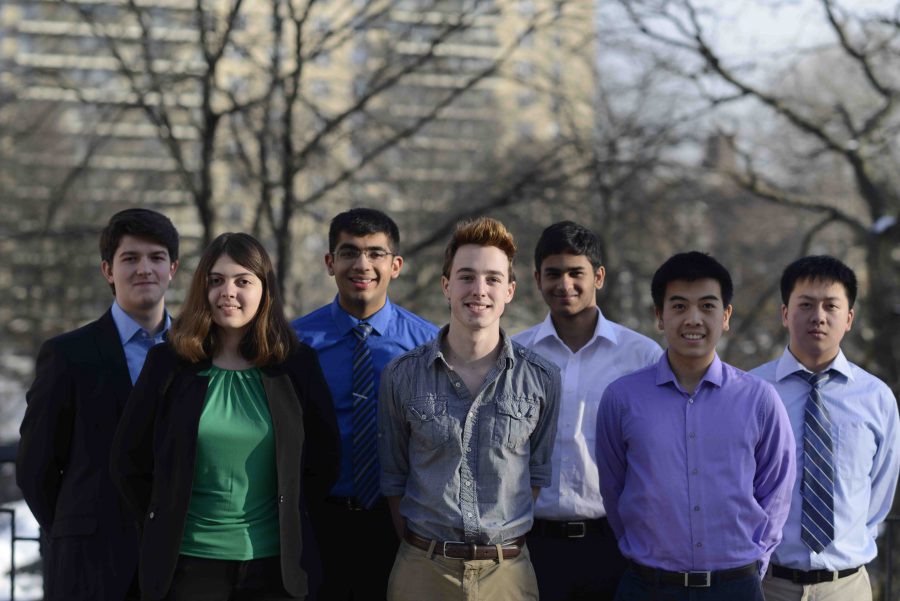Regeneron Names Seven Science Scholars: Greco Named Finalist
Regeneron Scholars and Finalist (from left to right) George Stefanakis ’17, Isabella Greco ’17 (finalist), Neeraj Sakhrani ’17, Aidan Gibbons ’17, Nikhil Devraj ’17, Ryan Foo ’17, and Tyrone Zhang ’17.
Under the new Science Talent Search sponsor Regeneron, seven Bronx Science students were named Scholars (formerly known as semifinalists) of the 2017 competition, around 9 a.m. on January 4, 2017.
The seven Scholars this year were Nikhil Devraj ’17 (math), Ryan Foo ’17 (social science), Aidan Gibbons ’17 (math), Isabella Greco ’17 (social science), Neeraj Sakhrani ’17 (math), George Stefanakis ’17 (math), and Tyrone Zhang ’17 (math). Greco was then named a finalist on Janury 24th, 2017.
Greco is now competing for a coveted college scholarship of up to $250,000. The Scholars have received $2,000 in scholarship money.
There were a total of 300 Scholars announced by the Regeneron Science Talent Search, the same number of semifinalists announced when the competition was sponsored by Intel.
Having worked since sophomore year, ninety-eight current seniors at Bronx Science submitted to the competition. The Science Talent Search, which was previously sponsored by technology corporation Intel, is now sponsored by the pharmaceutical company Regeneron. It is fitting to have this new sponsor, since Bronx Science is the alma mater of its CEO, George Yancopoulos ’76. He was a finalist during his senior year in 1976, and now is a sponsor for the competition.
The competition, often simply referred to as “Regeneron,” gives students around the world myriad opportunities to work alongside accomplished scientific professors, doctors, and researchers. By working collaboratively with these mentors, students develop their research project. Isabella Greco worked in social science, studying how gender stereotypes can subtly affect people’s memories of what they have read.
Greco’s research found that for jobs typically affiliated with women, such as teachers or nurses, people more often remembered statements that did not appear in the bibliography as doing so. As a finalist, Greco will travel to Washington, D.C. from March 9th to 15th, 2017 to compete for a top ten spot. Along with the social sciences, the Scholars also produced impressive projects in the hard sciences and math.
Many of our Science Research students spend years working in their mentor’s lab. They often work through mathematical problems, applying formulas and analyzing word problems. Many others spend hours peering through microscopes or working tirelessly to analyze their Western Blots. Some students spent hours conducting tests in statistical analysis programs such as SPSS. Although each research student follows a different path, they all share the same goal: to improve the quality of life.
For instance, Devraj’s project created an algorithm to help computers to better diagnose diseases. Sakhrani, also in the math research program, used a different program, Electron Spin Resonance (ESR), to date tooth samples from Tanzania. Foo studied the interactions between mothers and children and whether the different interactions affected the child’s transition from crawling to walking. Devraj relied on computers, algorithms, and generators, as did Sakhrani and Greco, to build their data set. Foo, on the other hand, developed his own code to analyze his data set.
Stefanakis also relied on his computer for the majority of his data set, creating a prototype for a hybrid computer. While Stefanakis and Devraj did most of their work from the computer, others worked in labs to compile their research.
Foo spent the majority of his junior year meeting with his mentor at the NYU Infant Action Lab, once a week after school and during the summer. He used videos that his mentor had already collected, but devised his own coding scheme to analyze the videos.
Sakhrani measured the age of artifacts using the facilities of Francis Lewis High School in Queens and the Thompson Chemistry Labs at Williams College in Massachusetts.
This competition and mentorship has helped prepare our hardworking students for the future, as the majority of the Scholars plan to enter the research field.
“This was a challenge, but it was a fun one to take on. I will certainly pursue research opportunities in college, and I am seriously considering it as my future career,” Greco said.
Devraj agreed with Greco, saying, “I plan to pursue research in college, and I am strongly considering academia as a career choice.”
This research experience has helped these Scholars to decide what to study when they enter college. “One of the reasons why I am interested in pursuing engineering is to learn the skills that I need, so that I can construct a large-scale, physical version of the model that I proposed in my research,” George Stefanakis, ’17 said.
This competition has helped to prepare some truly hardworking students.
The Regeneron Science Research process has given them a foundation for work that they can continue in college at well-known schools. Foo is planning to attend University of Pennsylvania next fall, where he can engage in research.
When hearing of the news, our Scholars reacted differently to their nominations, but were generally all excited.
“I shot my hands into the air and yelled ‘Yes!’ during the middle of my App Development class, when I received the notification. Everyone around me was utterly confused at my random burst of enthusiasm,” Devraj said.
“I was in disbelief when I heard of the result. In fact, the news came unexpectedly. I was anticipating that Regeneron would post the announcement at noon. However, as I walked into my third period Multivariable class, my friends told me the result. I didn’t believe them, until I saw a physical copy of the list online. I was ecstatic,” Neeraj Sakharani, ’17 said.
Putting together a project takes more than just a data table, as a Regeneron application includes a twenty page research report documenting their independent scientific research, along with essays and other supporting materials. The students rely on their teachers for help with completing the multi-part process of a Regeneron submission.
“ I was in disbelief of the result. The News came unexpectedly . . . I didn’t believe them, until I saw a physical copy of the list online.”
“The Regeneron Application has many components, requiring reviews which necessitates lots of e-mails, writing, and foresight. I help students to meet the deadlines for the paper, and I acted as an editor of the actual paper itself,” said Mr. Joshua Fialkow, a social science research teacher. “Successful candidates often don’t have the most earthshaking results, but they put great effort into clearly explaining the science and the data. They need to create an understandable and exciting story, one that shows that they understand the science involved,” said Dr. Julie Mankiewicz, biology teacher.

Isabella Greco is our 2017 Regeneron Science Talent Search Finalist.
Bronx Science’s seven Scholars’ projects ranged from creating codes and computer algorithms to studying the effects of a mother’s care on childhood development. They ranged in topic, field, and application. With 2017 Scholars in both mathematics and social science, our Regeneron Semifinalists reveal Bronx Science’s success in multiple academic departments and scientific disciplines, with a strong dedication to the mathematical roots of all scientific courses of study.
Eliana Chiovetta is a Staff Reporter for The Science Survey and a Reporter for the Student Life section of The Observatory. She has always loved writing,...

